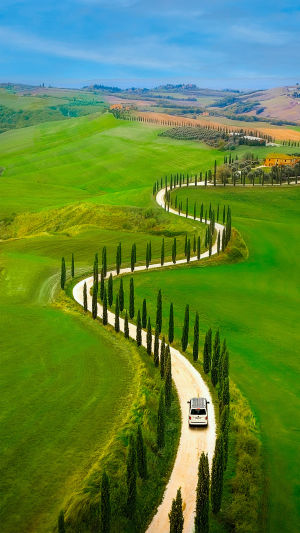It starts with a thought: "I need a vacation… but I'm tired of racing through it."
Many of us have felt this. The jam-packed itineraries, early wake-up calls, running from one landmark to the next—it's exhausting. This is why more travelers are embracing a global trend called slow travel.
Instead of ticking off attractions, slow travelers aim to savor the journey—living like a local, staying longer in one place, and building deeper connections with people and culture. Let's explore how this mindful way of traveling works and how we can start practicing it ourselves.
<h3>What Is Slow Travel?</h3>
Slow travel isn't just about moving slower. It's a mindset:
<b>Less checklist, more connection. Less rushing, more meaning. Less seeing, more experiencing.</b>
Here are some typical slow travel choices:
• Staying in local guesthouses or homestays
• Spending weeks (or months) in one city instead of country-hopping
• Choosing trains or buses over flights to enjoy the journey itself
• Shopping in local markets and cooking your own meals
• Learning the local language basics
• Volunteering or taking local classes
This trend grew especially after the pandemic. People now value deeper experiences and want to travel more sustainably, avoiding the crowds of mass tourism.
<b>1. Slow Travel Hotspot: Kyoto, Japan</b>
Kyoto is often rushed through in two days—visiting famous sites and quick shots for social media platforms. But if you stay longer, the city reveals its quiet soul.
• Where to stay: Traditional machiya houses (~$100–$150 per night)
• How to get there: Take the Shinkansen from Tokyo—2.5 hours, about $110 one-way
• Best time to visit: October–November (autumn leaves) or March–April (cherry blossoms)
Slow travel tips:
1. Visit Visit less-famous cultural sites.
2. Spend an afternoon exploring Nishiki Market and cooking local dishes.
3. Stroll through Arashiyama's back streets instead of just the bamboo grove.
Many slow travelers rent a bike ($10/day) to explore Kyoto's neighborhoods at a gentle pace.
<b>2. Slow Travel Hotspot: Tuscany, Italy</b>
Forget rushing between Florence, Pisa, and Rome. Instead, rent a stone house in a Tuscan village and stay for a few weeks.
• Where to stay: Agriturismo (farm stays) often cost $80–$120 per night with meals
• Best time to visit: May–June or September–October (pleasant weather, fewer tourists)
• Getting there: Fly into Florence or Pisa, then rent a car (~$50/day) to reach villages
Slow travel ideas:
1. Take a pasta-making workshop (~$70 per person).
2. Visit local markets for olive oil and cheese tastings.
3. Spend time chatting with farmers and learning about their daily lives.
4. Attend small-town events—many are free or cost just a few dollars for food and entertainment.
Instead of doing Tuscany in a weekend, living there for even 10–14 days lets you experience true Italian rhythm.
<b>3. Slow Travel Hotspot: Chiang Mai, Thailand</b>
Chiang Mai has become a global slow travel hub. Many travelers stay a month or longer, thanks to its affordability and rich culture.
• Where to stay: Guesthouses or apartments from $15–$50 per night
• Best time to visit: November–February (cool, dry season)
• How to get there: Fly from Bangkok (~$50 round trip)
Ideas for slow travelers:
1. Enroll in a Thai cooking school (~$30–$50 per class).
2. Volunteer at an elephant sanctuary (fees vary, often around $70–$100/day).
3. Take day trips to nearby mountains and hill tribe villages.
4. Join a local wellness retreat (donation-based or ~$100/week).
Local tip: Rent a scooter (~$8/day) to explore the countryside at your own pace.
<h3>Why Slow Travel Matters</h3>
<b>It's better for the planet, for local communities, and for your own well-being.</b>
According to the Center for Responsible Travel, slow travel reduces carbon emissions by encouraging longer stays and fewer flights.
Travel expert Rick Steves noted that travelers who spend more time in one place tend to support local businesses more meaningfully, fostering real cultural exchange.
And on a personal level? Slow travelers report lower stress, deeper learning, and greater satisfaction than those doing whirlwind tours.
<h3>How to Start Your Slow Travel Journey</h3>
If you're curious to try, here are some simple steps:
1. Pick one destination instead of multiple cities.
2. Book local lodging—avoid chain hotels when possible.
3. Plan unstructured days. Leave room for spontaneity.
4. Engage with locals—take classes, shop at markets, join community events.
5. Travel light and sustainably.
So, Lykkers, what do you think? Would you swap a packed 7-country tour for a month in one charming village or city? The next time you plan a trip, maybe give slow travel a try.
You might find that when you stop rushing, the world opens up in beautiful, unexpected ways.
Have you ever tried slow travel? Or do you have a dream destination you'd love to explore deeply? Share your thoughts—we'd love to hear your story! 🌏✨





